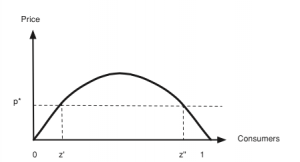Pricing with Network Effects
The article from Entrepreneur talks about some general rules about how to price a new product, where I found many connections between it and the Network Effects chapter in our textbook.
The author, Mark Stiving points about two important decisions that consumers usually have to make before they finally pay the money and buy some products. The two decisions are “Will I?” and “Which one?” If a consumer has no desire to get some product, he will have a very low “reservation price” for this product, as he is willing to pay very little to get this product. Making the consumer want some specific type of goods directly effects their decision of buying or not. After the consumer decides that he want a specific category of products, he will have to make a second decision of choosing which one to buy. In reality, there are usually many different brands that produce similar products, and it is sometimes hard for people to decide which one to buy.
Assume the company has a monopoly over a good that everyone wants to buy, then even if the price rises, people either have to pay more or try to use less of it. However, most of the cases are more likely to be a brand-new product and there already exist some similar products in the market. In this case, as Stiving states “pricing plays a major role in potential customers’ choosing to purchase or not”. As we learned, people tend to pay more for the product that already has many existing users. For a brand new product, there are no existing users. In order to increase its initial number of buyers, it is intuitive to price it lower than its competitor product’s prices. In the textbook, given common graph of relationship between a product’s price and % of consumer, we can easily notice that if the price is low, then it is easier to reach z’, the tipping point. After the number of consumer reaches this point, there will be an “upward pressure” on the consumption of the good, as more potential consumer will want to buy the product.
However, in real world, networks’ effect is much more complicated than just on pricing. Pricing definitely a vital factor that affects the outcome, but it also depends on the product type, the company’s reputation and its advertisement strategy. All of these factors can be affected by network. For instance, as Stiving mentioned, people are willing to pay more for the products that solve their immediate problems. People’s belief depends on not only their experiences, but also on the advertisements they see, the advise from their friends, etc. We will need a much more complex model to decide the price for a new product considering all these different aspects to ensure a successful launch.
Article link: http://www.entrepreneur.com/article/223398

